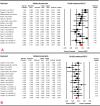Virtual reality-based therapy improves balance and reduces fear of falling in patients with multiple sclerosis. a systematic review and meta-analysis of randomized controlled trials
- PMID: 37041557
- PMCID: PMC10088228
- DOI: 10.1186/s12984-023-01174-z
Virtual reality-based therapy improves balance and reduces fear of falling in patients with multiple sclerosis. a systematic review and meta-analysis of randomized controlled trials
Abstract
Objective: This study aims to conduct a meta-analysis to assess the effect of virtual reality-based therapy (VRBT) on balance dimensions and fear of falling in patients with multiple sclerosis (PwMS). Secondarily, to determine the most recommendable dose of VRBT to improve balance.
Methods: PubMed Medline, Web of Science, Scopus, CINAHL and PEDro were screened, without publication date restrictions, until September 30th, 2021. Randomized controlled trials (RCTs) comparing the effectiveness of VRBT against other interventions in PwMS were included. Functional and dynamic balance, confidence of balance, postural control in posturography, fear of falling and gait speed were the variables assessed. A meta-analysis was performed by pooling the Cohen's standardized mean difference (SMD) with 95% confidence interval (95% CI) using Comprehensive Meta-Analysis 3.0.
Results: Nineteen RCTs, reporting 858 PwMS, were included. Our findings reported that VRBT is effective in improving functional balance (SMD = 0.8; 95%CI 0.47 to 1.14; p < 0.001); dynamic balance (SMD = - 0.3; 95%CI - 0.48 to - 0.11; p = 0.002); postural control with posturography (SMD = - 0.54; 95%CI - 0.99 to - 0.1; p = 0.017); confidence of balance (SMD = 0.43; 95%CI 0.15 to 0.71; p = 0.003); and in reducing fear of falling (SMD = - 1.04; 95%CI - 2 to - 0.07; p = 0.035); but not on gait speed (SMD = - 0.11; 95%CI: - 0.35 to 0.14; p = 0.4). Besides, the most adequate dose of VRBT to achieve the greatest improvement in functional balance was at least 40 sessions, five sessions per week and 40-45 min per sessions; and for dynamic balance, it would be between 8 and 19 weeks, twice a week and 20-30 min per session.
Conclusion: VRBT may have a short-term beneficial role in improving balance and reducing fear of falling in PwMS.
Keywords: Fear of falling; Gait speed; Multiple sclerosis; Postural balance; Postural control; Virtual reality.
© 2023. The Author(s).
Conflict of interest statement
The author(s) declare no potential competing interests with respect to the research, authorship, and/or publication of this article.
Figures




Similar articles
-
Virtual Reality-Based Therapy Improves Fatigue, Impact, and Quality of Life in Patients with Multiple Sclerosis. A Systematic Review with a Meta-Analysis.Sensors (Basel). 2021 Nov 6;21(21):7389. doi: 10.3390/s21217389. Sensors (Basel). 2021. PMID: 34770694 Free PMC article.
-
The effect of virtual reality-based therapy on fear of falling in multiple sclerosis: A systematic review and meta-analysis.Mult Scler Relat Disord. 2022 Jul;63:103791. doi: 10.1016/j.msard.2022.103791. Epub 2022 Apr 10. Mult Scler Relat Disord. 2022. PMID: 35472718
-
The effect of Tai Chi in elderly individuals with sarcopenia and frailty: A systematic review and meta-analysis of randomized controlled trials.Ageing Res Rev. 2022 Dec;82:101747. doi: 10.1016/j.arr.2022.101747. Epub 2022 Oct 9. Ageing Res Rev. 2022. PMID: 36223875
-
Cognitive behavioural therapy (CBT) with and without exercise to reduce fear of falling in older people living in the community.Cochrane Database Syst Rev. 2023 Nov 15;11(11):CD014666. doi: 10.1002/14651858.CD014666.pub2. Cochrane Database Syst Rev. 2023. PMID: 37965937 Free PMC article.
-
Virtual reality for rehabilitation in Parkinson's disease.Cochrane Database Syst Rev. 2016 Dec 21;12(12):CD010760. doi: 10.1002/14651858.CD010760.pub2. Cochrane Database Syst Rev. 2016. PMID: 28000926 Free PMC article.
Cited by
-
An Immersive Virtual Kitchen Training System for People with Multiple Sclerosis: A Development and Validation Study.J Clin Med. 2023 Apr 30;12(9):3222. doi: 10.3390/jcm12093222. J Clin Med. 2023. PMID: 37176662 Free PMC article.
-
Managing multiple sclerosis in individuals aged 55 and above: a comprehensive review.Front Immunol. 2024 Apr 5;15:1379538. doi: 10.3389/fimmu.2024.1379538. eCollection 2024. Front Immunol. 2024. PMID: 38646534 Free PMC article. Review.
-
Effectiveness of virtual reality technology in rehabilitation after anterior cruciate ligament reconstruction: A systematic review and meta-analysis.PLoS One. 2025 Mar 3;20(3):e0314766. doi: 10.1371/journal.pone.0314766. eCollection 2025. PLoS One. 2025. PMID: 40029868 Free PMC article.
-
Will you accept a virtual human as a friend? Exploring the role of virtual humans in mood management and mental health support.Front Public Health. 2025 Apr 4;13:1555218. doi: 10.3389/fpubh.2025.1555218. eCollection 2025. Front Public Health. 2025. PMID: 40255380 Free PMC article.
-
Association between personality traits and concerns about falling among older patients: the mediating role of subjective age.Front Public Health. 2024 Aug 16;12:1343939. doi: 10.3389/fpubh.2024.1343939. eCollection 2024. Front Public Health. 2024. PMID: 39220451 Free PMC article.
References
Publication types
MeSH terms
LinkOut - more resources
Full Text Sources
Medical

